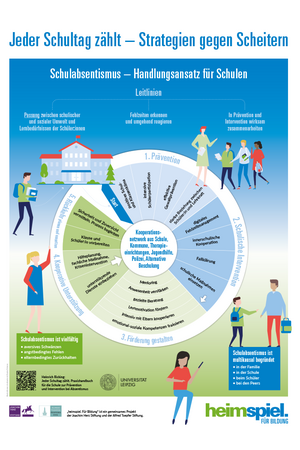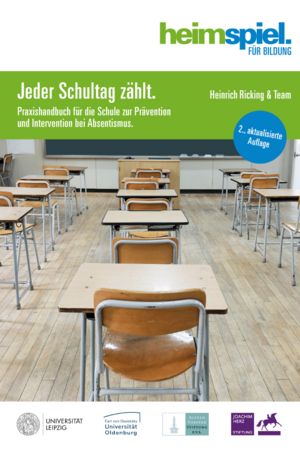Every school day counts
Strategies against failure

According to estimates, five to ten percent of all students in Germany are regularly absent from class, and almost six leave school without graduating. What can schools do to combat absenteeism and dropout - this question was the focus of the "Every School Day Counts" project.
At a glance
Traditionally, school absenteeism has been viewed as a problem under school law, punished by sanctions and coercive measures. However, it is much more important to strengthen attendance and participation in lessons and school life and to pursue an effective approach to absenteeism.
From 2019 to 2022, the elementary school Neugraben, the elementary school Großlohering, the elementary and district school Altrahlstedt, and the district school Süderelbe, under the leadership of the nationally recognized absenteeism researcher Professor Heinrich Ricking and a team from the Carl von Ossietzky University Oldenburg, tested effective and practical strategies against academic failure and thus increased the attendance rates of their students.
Causes and forms of truancy
Truancy is a technical term that describes all problem situations and behavior patterns in which students are absent from school without authorization. Truancy is multifaceted and can be divided into three forms:
- Aversive truancy: Truancy involves sitting out of class in favor of a more pleasurable activity, especially outside the home during the morning, and the student:s often have developed dismissive thoughts and feelings about school.
- Anxiety-related school avoidance: Anxiety-related school avoidance implies that the student:s avoid school because of their experience of anxiety. This form is often accompanied by concrete factors (e.g., bullying or fear of failure) as well as psychosomatic complaints.
- Withholding by legal guardians: In the case of truancy with parental tolerance or withholding, the decisive criterion is the consent, support or tolerance of the legal guardians for the absence from school.
9 tips against absenteeism and for more holding power
1. an open attitude in the college that leads to pedagogical solutions
An important prerequisite is an open and solution-oriented attitude of teachers, from which helpful activities for the prevention of absenteeism arise:
- no trivialization
- individual case clarification
- Promote social integration of students
- Preventing the process of habituation
- Enable learning successes
- Recognize warning signals
The poster can be downloaded here.
2. a clear data situation about presence and absence
A prerequisite for dealing appropriately with school absences is that they are noticed in the first place. This means that student attendance must be the focus of teachers, and appropriate routines in data recording should be established to enable an assessment of the situation and to identify patterns.
2. a reliable and immediate reaction of the school to failures.
If neither excuse nor student:in arrives at school, teachers or responsible school personnel must react promptly, for example by calling the parent or guardian or by going to see, speak to or pick up the student. In this way, the school emphasizes the importance of the presence of each individual child and adolescent, and signals knowledge and a clear attitude. In the event of an emergency, the school may initiate truancy procedures. This specifies exactly what actions are to follow and what outside help is to be called in.
4. positive premises and good school climate
The school atmosphere plays a major role in ensuring that everyone involved enjoys being at school. That's why the four Hamburg schools have worked with their students to redesign the rooms and outdoor areas so that they are more in line with the needs of the children and young people and create an emotional bond with the school. At the Altrahlstaedt district school, for example, one year group embellished the toilets with purple tiles and ornate mirrors, while another furnished a recreation room in a pretty way. This is how school becomes a place of well-being.
5. safety of all students
Social conflicts are part of everyday school life. Schools and teachers have many ways to prevent violence and bullying. Violence affects the social climate at school and has a major impact on whether students attend school regularly. The practical manual "Every school day counts" presents de-escalation measures and concrete measures against bullying.
6. create positive relationship
Particularly when dealing with conspicuous behavior in the classroom, it is a special challenge to decide how much freedom and how much boundaries the student needs. In individual cases, this means developing a sensitive feeling for how much warmth and attention the respective student needs in everyday school life.
7. promotion of emotional-social competences of students.
Students who attend school irregularly often have a pronounced need for counseling. They need information and support to solve their problems and to develop behavioral alternatives to absconding or avoidance. Even if truancy is the underlying problem, students should be encouraged to use their own skills to initiate effective change processes.
Teachers and schools can, for example:
- offer counseling
- train their students in emotional and social skills
- use buddy concepts
- Reinforce positive behavior
- develop problem-solving strategies
- Promote self-regulation
8. a good cooperation with the legal guardians
To prevent truancy, close cooperation between parents and school is important. However, educational partnership does not only mean the exchange of information about the child's behavior, development and upbringing in the family and school, but it goes a decisive step further: parents, educators and teachers try to coordinate their educational goals, methods and efforts, to shape the educational process together, to complement and support each other. In this way, a certain continuity is to be created between the areas of life of the children and adolescents.
9. networking with extracurricular institutions
The success of truancy prevention depends crucially on good cooperation between schools and the supporting services in the environment and at different levels. It is therefore important to break down barriers related to differences in understanding of the subject matter, unrecognized benefits of cooperation, human or time resources, or the structural integration of cooperation.
Effective prevention of truancy cannot be achieved by a single measure, but must be embedded in a coherent overall concept within a positive school culture. This means that school administrators, teachers and school staff must always take various aspects into account.
Results from the project schools
Despite unfavorable pandemic-related conditions, the project results show that Neugraben Elementary School, Großlohering Elementary School, Altrahlstedt Elementary and District School, and Süderelbe District School have made significant progress in preventing absenteeism.
- All schools have been working on systematic registration of attendance and absences. This involved technical requirements, hardware and software, but also convincing and motivating school colleagues that this registration and rapid responses to absences are important.
- All participating schools have invested in the prevention of absenteeism. They have paid special attention to absenteeism, shared information about possible causes among their staff, and provided continuing education. They have changed procedures and established new, preventive structures. For example, they have established who "collects" the names of absent students in the morning and contacts parents in a timely manner.
- All schools have introduced forms of participation and worked on their room and time concepts. These included a new rhythm for the school day at an elementary school or attractive break rooms and the design of the break yard at a secondary school.
Many project participants are certain that "Every School Day Counts" not only counteracts absenteeism, but also improves school quality. For example, the Altrahlstedt Elementary and District School.
This movie is hosted on YouTube. The video will only be active after clicking the button. Please note that this results in the transmission of data to the USA with an insecure level of data protection.
Develop your own strategies against absenteeism
Practical handbook for schools on the prevention and intervention of truancy.
The contents provide scientifically validated knowledge for action, give concrete intervention measures and help to increase the professionalism of teachers. Teachers receive tips and methods for practice, checklists, copy templates and a poster for the staff room.
All materials from the project can be downloaded here.
Contact


